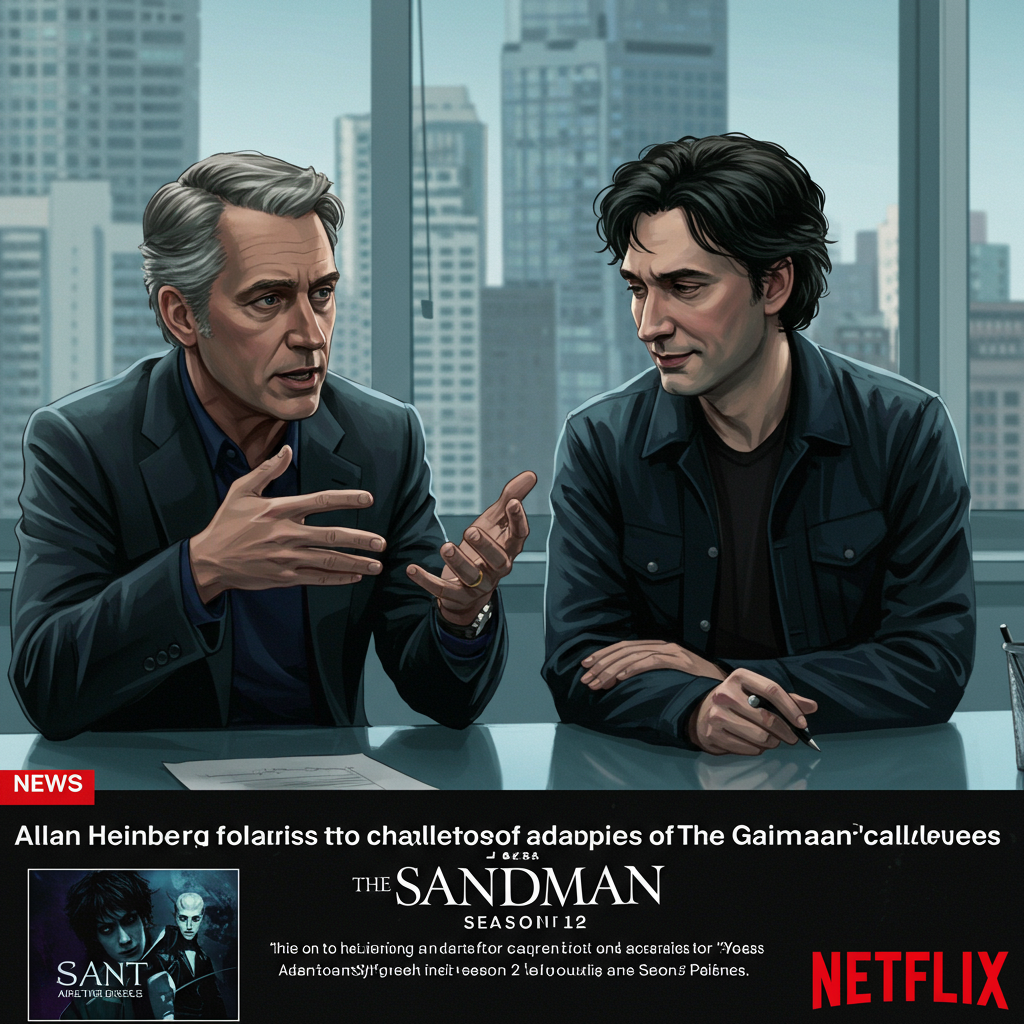Netflix’s The sandman returns for its highly anticipated second season, delving further into the complex world of the Endless and their relationships. Showrunner Allan Heinberg faced the significant challenge of adapting some of Neil Gaiman’s most discussed and potentially controversial comic book narratives for a modern audience. This involved delicate balancing acts, particularly concerning the portrayal of the trans character Wanda from the “A Game of You” arc and the fraught dynamic between dream and the ancient queen Nada. Furthermore, the production and release of Season 2 have occurred under the shadow of serious allegations against creator Neil Gaiman, adding another layer of complexity to how viewers might engage with the show.
Adapting Wanda: Navigating Representation and Erasure Concerns
One of the most notable shifts in The Sandman Season 2 involves the character Wanda. In the original 1993 comic arc “A Game of You,” Wanda, a trans woman, is a central figure and best friend to Barbie, who is connected to a vibrant dream world. The comic was groundbreaking for its inclusion of a trans character but also drew significant criticism for Wanda’s eventual fate. She suffered nightmares of forced surgery, was denied entry to the dream realm based on perceived gender by other characters like Thessaly and the Moon, died, was dead-named by her family at her funeral, and only appeared as a woman in a dream afterlife. Critics labeled this a tragic queer trope, suggesting a problematic message about death as an escape or happy ending for a trans character.
Showrunner Allan Heinberg made the strategic decision to cut the “A Game of You” arc entirely from Season 2. This choice was partly driven by the show’s overarching narrative focus on Dream’s story during this period, which centers on the “Brief Lives” storyline. However, Heinberg felt strongly that Wanda must remain in the series. He explicitly stated concerns about potential backlash and headlines accusing the show or Netflix of “trans erasure” or transphobia if such a significant character were omitted, emphasizing that these accusations would be untrue regarding the production’s intentions.
Heinberg, having read The Sandman comics as a young gay man, viewed Wanda’s original inclusion in “A Game of You” as “extraordinary” representation for its time. To retain her presence and importance without adapting the controversial “A Game of You” storyline, Wanda (portrayed by Indya Moore) was seamlessly integrated into the “Brief Lives” arc. She replaces the minor comic character Ruby, serving as a chauffeur and bodyguard for Dream (Tom Sturridge) and his younger sister Delirium (Esmé Creed-Miles) as they embark on a quest to find their missing brother, Destruction (Barry Sloane).
In this new role, Heinberg describes the adapted Wanda as more “adept” and “wiser” than the Endless siblings she accompanies. She navigates the waking world more skillfully than Dream and Delirium, often offering insights that help them understand themselves and their fraught relationship. While her trans identity is acknowledged, it’s primarily used to illustrate her estranged family dynamics, which resonate with Dream and Delirium’s own family conflicts. This approach avoids the problematic elements of her comic book arc, allowing her identity to inform her character and interactions without being the sole focus or leading to a tragic end. Heinberg lauded Indya Moore’s performance, noting how the actress brought elements of her own biography to the role, creating a character the show’s team fell in love with.
Reimagining Nada’s Fate and Dream’s Cruelty
Another highly controversial plot point in the comics involves Dream’s centuries-long relationship with Nada, the queen of the first human civilization. Despite the forbidden nature of their love, Dream and Nada fall deeply for each other, leading to the destruction of Nada’s city. In the original story, Nada kills herself in despair. Dream continues to pursue her even in the afterlife, and when she refuses to remain with him, he condemns her to spend 10,000 years suffering in Hell as punishment for rejecting him.
The comic book portrayal of Dream’s actions towards Nada has been difficult for many readers to reconcile, presenting him as incredibly cruel and unforgiving. Heinberg acknowledged the validity of the comic version but found it challenging to make Dream a character modern audiences could continue to support and understand after such an act. His goal for the adaptation was to write Dream in a way that made his choices comprehensible, even if not justifiable.
In The Sandman Season 2, the narrative surrounding Nada (played by Umulisa Gahiga) is recontextualized. The concept of Hell is explained by Lucifer (Gwendoline Christie) not merely as divine punishment but as a place where humans endure the torment they believe they deserve. In this version, Nada feels immense guilt over the destruction of her city, believing she must pay a price for succumbing to her feelings for Dream. While Dream still sends her to Hell, the show frames it partially as Nada condemning herself due to her overwhelming guilt and partially as Dream acting out of wounded pride and anger over her rejection. His sister, Death (Kirby), later confronts Dream, pointing out that he put Nada in an impossible situation from the start. This adaptation emphasizes Dream’s growing understanding and empathy over 10,000 years, suggesting he eventually realizes his past behavior was “abominably terrible.” While the fundamental outcome of Nada’s long suffering in Hell remains severe, the show attempts to provide the audience with insight into the motivations and psychological state of both characters, particularly Dream’s pride and Nada’s guilt, making his actions, while still terrible, more narratively explicable from his perspective.
Cutting “A Game of You” also impacted the show’s adaptation of Dream’s emotional state leading into “Brief Lives.” In the comics, Dream’s depression and subsequent quest with Delirium are triggered by the end of a brief affair with Thessaly (a major character in “A Game of You”). With Thessaly’s role reduced in the show due to the cut arc, Dream’s motivation for joining Delirium’s search for Destruction is instead tied directly to his unresolved feelings for Nada. He is shown moping after her latest rejection and is driven to find her in the waking world, providing a more direct emotional through-line connecting his past actions with Nada to his journey in Season 2.
The Shadow of Controversy: Art, Artist, and Audience Choice
The release of The Sandman Season 2 is overshadowed by serious allegations of sexual assault and abuse against Neil Gaiman, the author and co-creator of the series. Multiple women have come forward with accusations detailing graphic and violent acts, holding women captive, and sexual violations, among other claims. A lawsuit alleging human trafficking involving Gaiman and his ex-wife has also been reported. While Gaiman has denied all allegations, the situation has led to him being dropped by publishers and has reportedly impacted other planned adaptations of his work, including Good Omens and The Graveyard Book.
This context forces viewers and critics to grapple with the perennial question: can the art be separated from the artist, especially when allegations are this severe? For some, the link between Gaiman and his work, particularly The Sandman and its protagonist Morpheus, is too strong to ignore. Some argue that Morpheus was always perceived as a self-insert for the author. Through this lens, plot points in the comics and show, such as the “Calliope” story (where a Muse is held captive and raped for inspiration) or Dream’s punitive treatment of Nada, take on a disturbing new resonance. Critics suggest that what might have once seemed like explorations of dark themes or character flaws now feel uncomfortably like reflections or even attempted justifications or redemption arcs for Gaiman’s alleged real-life actions. For those who feel this connection is undeniable, watching the show becomes a “grueling” or “physically painful” experience.
The situation is further complicated by the numerous other people involved in creating the show – the cast, writers, crew, whose livelihoods depend on its release and success. However, many argue that engaging with the show financially (through Netflix subscriptions tied to viewership) represents a “vote” that supports the creator, potentially enabling him financially amidst legal battles and accusations. The ethical dilemma for audiences is real: support the work of many talented individuals, or make a conscious choice to disengage to avoid supporting someone accused of serious harm, even if they deny the claims.
The Show’s Future and Unusual Release Strategy
Adding to the complex narrative surrounding Season 2 is the fact that it has been announced as the final season of The Sandman. While the series was initially seen as a potential flagship franchise for Netflix, its future became uncertain after the allegations against Gaiman surfaced during Season 2’s production. Reports suggested the controversy contributed to the decision to conclude the series earlier than some might have expected. Showrunner Allan Heinberg, however, maintains that the decision to end the series with Season 2 was a creative one, planned “three years ago” (around 2022) based on the remaining “Dream material” from the comics. He described the timing of Netflix’s announcement in January 2025, which coincided with increased negative press about Gaiman, as merely “unfortunate timing.” He stated that the allegations did not significantly impact the show’s production process itself, which was already scheduled years in advance.
Netflix has adopted an unusual release strategy for this final season. Unlike typical binge models or even recent split-season releases (like Bridgerton or Stranger Things Volumes), which usually have a month or more between parts to build anticipation, The Sandman Season 2 is being released in two volumes with a much shorter gap. The first block premiered on July 3, with the second block following just three weeks later on July 24. This truncated release schedule has led some to speculate that Netflix is undecided on how to handle the show amidst the controversy, perhaps seeking to quickly release the content rather than leverage it as a long-term promotional tool, even if it means forgoing a more standard gap designed to maximize viewership engagement and discussion over a longer period.
Regardless of the external factors, The Sandman Season 2 attempts to provide a compelling adaptation of pivotal comic arcs. The show features standout performances, including Esmé Creed-Miles’s portrayal of Delirium, whose unique costume was a collaborative effort reflecting her character interpretation. The show navigates the challenges of adapting complex, sometimes dated, source material for a contemporary audience while simultaneously existing within a turbulent real-world context surrounding its creator. The choices made in adapting characters like Wanda and Nada reflect a deliberate effort by the showrunners to address past criticisms and create a narrative they felt was both faithful in spirit and relevant for viewers today, even as external controversies complicate its reception.
Frequently Asked Questions
How did Netflix’s Sandman Season 2 change controversial comic characters like Wanda and Nada?
The show made significant changes to adapt controversial characters. For Wanda, her “A Game of You” storyline, criticized for its tragic and problematic portrayal, was cut. Instead, she was integrated into the “Brief Lives” arc as a capable companion to Dream and Delirium, avoiding the original comic’s issues. For Nada, Dream’s cruel act of condemning her to Hell was recontextualized. The show emphasizes Nada’s self-condemnation due to guilt over her city’s fate and Dream’s actions stemming from wounded pride, with Dream later realizing his behavior was terrible, aiming to make his motivations more understandable to a modern audience.
What specific comic book arcs are adapted in Sandman Season 2?
The Sandman Season 2 primarily adapts the “Brief Lives” comic arc, which follows Dream and Delirium’s journey to find their missing brother, Destruction. While the original article mentions a planned adaptation of “A Game of You” featuring Wanda, showrunner Allan Heinberg decided to cut this arc to maintain focus on Dream’s main narrative in “Brief Lives.” Key characters and elements from “A Game of You,” such as Wanda and possibly Thessaly (though her role is reduced), were instead integrated into the “Brief Lives” storyline in altered capacities.
Should Neil Gaiman’s recent allegations influence whether I watch Sandman Season 2?
Whether to watch The Sandman Season 2 amidst serious allegations against creator Neil Gaiman is a complex personal decision. Allegations of abuse and assault have led some to feel that Gaiman is inseparable from his work, viewing show elements differently through this lens. Others argue that the show involves the work of many people (cast, crew) whose efforts deserve recognition. Engaging with the show financially via streaming supports the creator, potentially enabling legal defense funding, which some find problematic. Ultimately, the decision depends on an individual’s stance on separating art from the artist and their comfort level supporting a project tied to someone facing such accusations.



